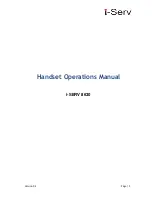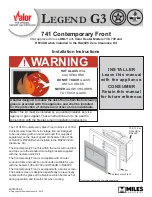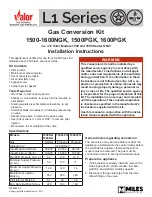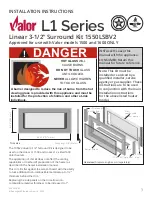
18
-
before reversing with the tractor or for direction
changes at the end of the field, the operator must
necessarily place the equipment (both mounted
and pull-type) in
transport configuration
, as
described in the previous paragraph, and lift from
ground the tines of central rotary units. Perform
this intervention by lifting the tractor hydraulic lift
for
pull-type
, or by extending the relative cylinder
for
the
mounted
type,
handling
the
corresponding lever in the cabin (see also section
“Change of direction or reverse”). The hay tedder
could suffer serious damage if the teeth were not
raised;
-
the hay tedder operation does not produce a
noise level that allows the use of hearing
protection (plugs, headphones, etc..), however
the tractor could produce it. For this regard,
consult the tractor use and maintenance manual;
-
the vibrations that the equipment may produce
and transmit to the operator are of low intensity
and the frequency is below human tolerability
levels.
However, it is good always to keep the
transmission and the gears well lubricated.
Immediately interrupt work operations if:
-
you are in proximity of resistant objects, such as
manholes, wells, trees, etc. since contact could
break the tines, and projected the pieces all
around at high speed;
-
noisy vibrations coming from the equipment are
heared. To avoid possible damages, the operator
should stop the tractor, disengaged the PTO,
switched off the engine and if possible, identify
and remedy the situation, always in respect with
safety regulations.
Reasonably foreseeable misuse and limit of
employ
A different use from that one described in the
previously paragraph
is considered improper and
therefore forbidden.
In addition, the technical
characteristics of the equipment must not be modified
in any way to alter its performance.
In this case,
both
the
equipment
warranty
and
the
Manufacturer liability would immediately become
void
.
Visibility:
in conditions of insufficient visibility (fog,
dust, smoke or other): it is advisable to stop the
tractor and to wait until that fog, dust or other goes
away. Operate at the same way in case of
wind
and/or
rain.
-
prima di andare con il trattore in retromarcia o
per cambi di direzione a fondo campo, l’opera-
tore deve necessariamente mettere l’attrezzatura
(sia portata che trainata) la
configurazione da
trasporto
(vedi paragrafo precedente), e solle-
vare da terra i denti dei gruppi rotativi centrali.
Per questo basterà sollevare il sollevatore
idraulico del trattore per il tipo
portato
oppure
estendendo il relativo martinetto, agendo in
cabina sulla rispettiva leva, per il tipo
trainato
(vedi anche il paragrafo
“Cambio di direzione o
retromarcia trattore
”). L’attrezzatura potrebbe
riportare seri danni se i denti non venissero
sollevati;
-
il funzionamento del spandivoltafieno non
produce una rumorosità tale da consentire
l’utilizzo di protezioni acustiche (tappi, cuffie,
ecc.), ma il trattore, invece, potrebbe produrla. Al
riguardo, è opportuno consultare il manuale di
uso e manutenzione del trattore;
-
le vibrazioni
prodotte dall’attrezzatura e che
giungono all’operatore sul trattore sono di bassa
intensità ed hanno una frequenza tale da
risultare inferiore ai livelli sopportabili dal corpo
umano.
Tuttavia, è bene mantenere gli organi
di trasmissione e gli ingranaggi sempre ben
lubrificati.
Interrompere immediatamente il lavoro se:
-
si è in prossimità di oggetti resistenti, quali
tombini, pozzetti, alberi, ecc. in quanto il contatto
potrebbe provocare la rottura dei denti, i cui
pezzi potrebbero anche essere proiettati intorno
ad altissima velocità;
-
si avvertono vibrazioni rumorose del
l’attrezza-
tura. Per evitare possibili danni, sarà opportuno
fermare il trattore, disinserire la presa di forza,
arrestare il motore e se possibile individuare ed
eliminare l’inconveniente, osservando le norme
di sicurezza previste.
Uso scorretto ragionevolmente prevedibile e
limiti d’impiego
Un uso dello spandivoltafieno diverso da quello
descritto nel paragrafo precedente è da considerarsi
scorretto, e quindi,
vietato
. Inoltre, le sue
caratteristiche tecniche non devono, in alcun modo,
essere alterate per modificarne le prestazioni.
Se ciò
si dovesse verificare, sia la garanzia dell’attrezza-
tura che la responsabilità del Fabbricante si
annullerebbero immediatamente
.
Visibilità:
in condizioni di scarsa visibilità (nebbia,
polvere, fumo od altro): si consiglia di fermare il
processo lavorativo ed aspettare finché nebbia,
polvere, fumo od altro si attenui. Comportarsi allo
stesso modo in caso di vento e/o di pioggia.
Содержание G6V 3P
Страница 8: ...8 G6V 3P MOUNTED TYPE TIPO PORTATO G6V PT PULL TYPE TIPO TRAINATO ...
Страница 38: ...38 Note ...
Страница 39: ......
















































